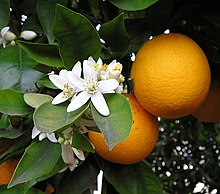| Citrus Temporal range:
| |
|---|---|

| |
| Sweet orange (Citrus × sinensis cultivar) | |
| Scientific classification | |
| Kingdom: | Plantae |
| Clade: | Tracheophytes |
| Clade: | Angiosperms |
| Clade: | Eudicots |
| Clade: | Rosids |
| Order: | Sapindales |
| Family: | Rutaceae |
| Subfamily: | Aurantioideae |
| Genus: | Citrus L. |
| Species and hybrids | |
|
Ancestral species: Important hybrids: | |
| Synonyms[2] | |
| |
Citrus is a genus of flowering trees and shrubs in the family Rutaceae. Plants in the genus produce citrus fruits, including important crops such as oranges, mandarins, lemons, grapefruits, pomelos, and limes.
Citrus is native to South Asia, East Asia, Southeast Asia, Melanesia, and Australia. Indigenous people in these areas have used and domesticated various species since ancient times. Its cultivation first spread into Micronesia and Polynesia through the Austronesian expansion (c. 3000–1500 BCE). Later, it was spread to the Middle East and the Mediterranean (c. 1200 BCE) via the incense trade route, and from Europe to the Americas.
Renowned for their highly fragrant aromas and complex flavor, citrus are among the most popular fruits in cultivation. With a propensity to hybridize between species, making their taxonomy complicated, there are numerous varieties encompassing a wide range of appearance and fruit flavors.
- ^ Wu, Guohong Albert (7 February 2017). "Genomics of the origin and evolution of Citrus". Nature. 554 (7692): 311–316. Bibcode:2018Natur.554..311W. doi:10.1038/nature25447. hdl:20.500.11939/5741. PMID 29414943. S2CID 205263645.
- ^ "Citrus L.". Plants of the World Online. Royal Botanic Gardens, Kew. Retrieved 10 September 2021.